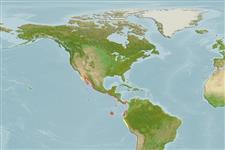Environment: milieu / climate zone / depth range / distribution range
Ecologia
marinhas associadas(os) a recifes; intervalo de profundidade 21 - 40 m (Ref. 5222). Subtropical; 33°N - 13°S, 118°W - 76°W (Ref. 5222)
Eastern Pacific: southern California, USA to Peru, including Revillagigedo and Galapagos Islands, Cocos Island, Clipperton Island.
Tamanho / Peso / Idade
Maturity: Lm ? range ? - ? cm
Max length : 100.0 cm TL macho/indeterminado; (Ref. 5222); peso máx. Publicado: 12.5 kg (Ref. 4699)
Descrição breve
Chaves de identificação | Morfologia | Morfometria
Espinhos dorsais (total) : 11; Raios dorsais moles (total) : 18 - 20; Espinhos anais: 3; Raios anais moles: 9. Distinguished by the following characteristics: body depth, 2.1-2.5 in SL; dorsal profile of head is steep; eye diameter less than snout length, 5.2-8.0 in HL; short pectoral fins, length 18-26% of SL; rounded caudal fin; smooth scales, mostly covered by skin; lateral line scales 62-67 (Ref. 089707).
A diurnal predator that feeds on small benthic fishes and occasionally on crustaceans. Often it uses browsing herbivorous fishes as a moving blind in order to feed on the cryptic fauna disturbed by these browsers; it will also follow foraging moray eels to catch the fishes frightened from their hiding places. Small juveniles have been seen hiding among the long spines of the dark-colored sea urchin, Centrostephanus coronatus.
Life cycle and mating behavior
Maturities | Reprodução | Spawnings | Egg(s) | Fecundities | Larvas
Heemstra, P.C. and J.E. Randall, 1993. FAO Species Catalogue. Vol. 16. Groupers of the world (family Serranidae, subfamily Epinephelinae). An annotated and illustrated catalogue of the grouper, rockcod, hind, coral grouper and lyretail species known to date. Rome: FAO. FAO Fish. Synop. 125(16):382 p. (Ref. 5222)
Categoria na Lista Vermelha da IUCN (Ref. 130435)
Ameaça para o homem
Harmless
Utilização humana
Pescarias: pouco comercial; peixe desportivo: sim
Ferramentas
Relatórios especiais
Descarregue XML
Fontes da internet
Estimates based on models
Preferred temperature (Ref.
123201): 23 - 26.3, mean 24.6 °C (based on 7 cells).
Phylogenetic diversity index (Ref.
82804): PD
50 = 0.6250 [Uniqueness, from 0.5 = low to 2.0 = high].
Bayesian length-weight: a=0.01148 (0.00558 - 0.02364), b=3.04 (2.88 - 3.20), in cm total length, based on LWR estimates for this (Sub)family-body shape (Ref.
93245).
Nível Trófico (Ref.
69278): 4.5 ±0.80 se; based on food items.
Resiliência (Ref.
120179): Muito baixo, tempo mínimo de duplicação da população maior que 14 anos (Preliminary K or Fecundity.).
Fishing Vulnerability (Ref.
59153): High vulnerability (60 of 100).
Nutrients (Ref.
124155): Calcium = 13.4 [7.5, 27.8] mg/100g; Iron = 0.458 [0.229, 0.802] mg/100g; Protein = 19.5 [17.6, 21.1] %; Omega3 = 0.193 [0.111, 0.339] g/100g; Selenium = 16.7 [7.6, 35.5] μg/100g; VitaminA = 71.9 [22.3, 259.5] μg/100g; Zinc = 0.509 [0.328, 0.786] mg/100g (wet weight);
